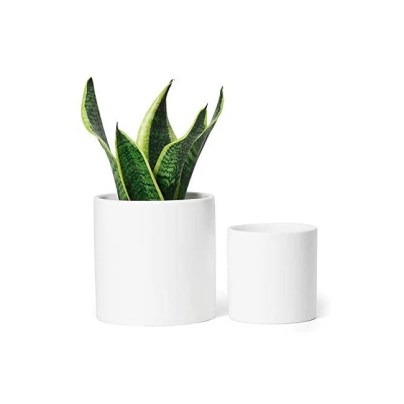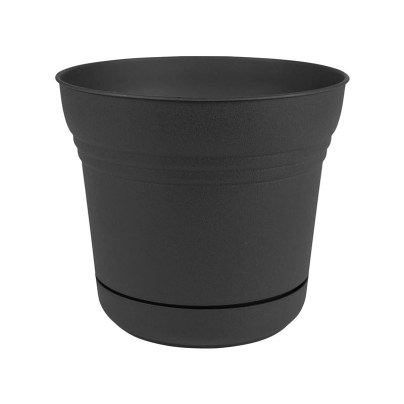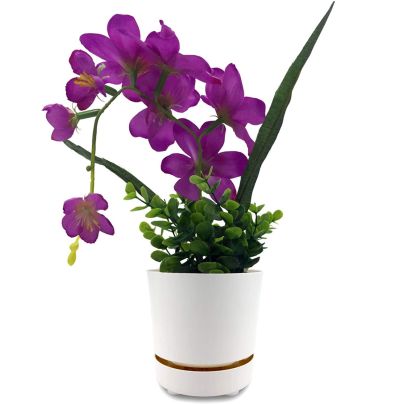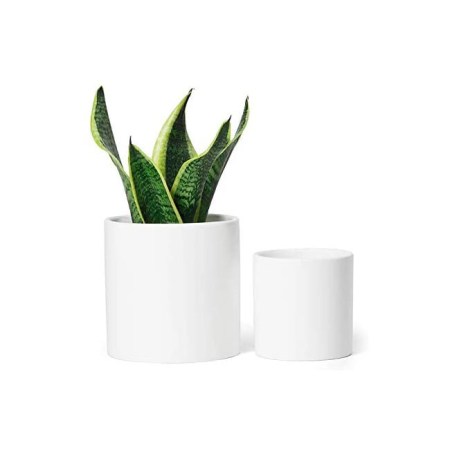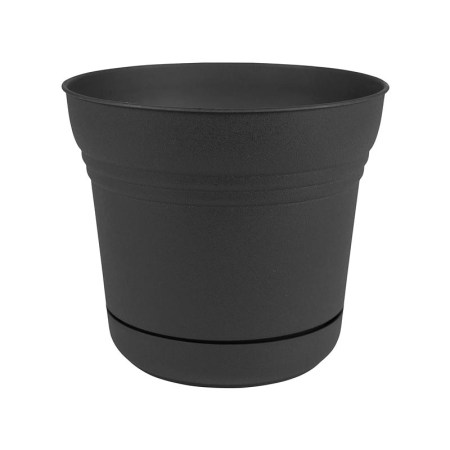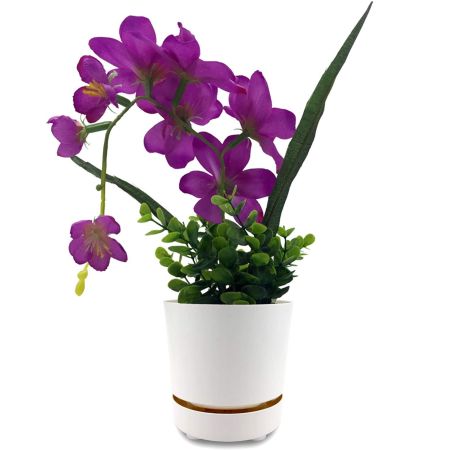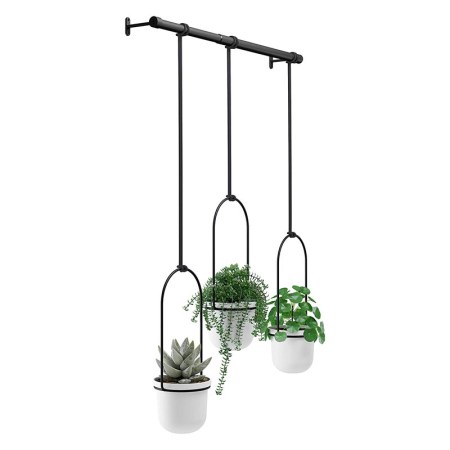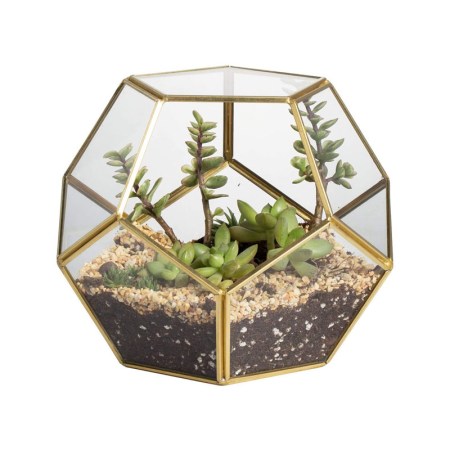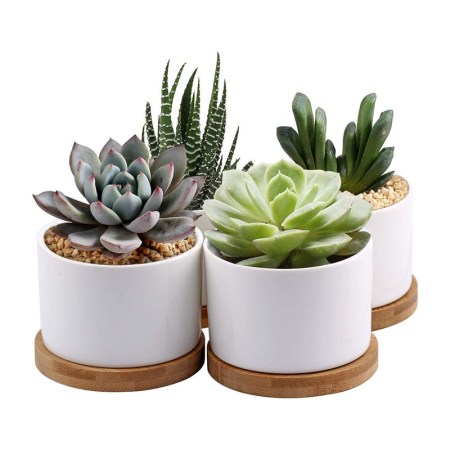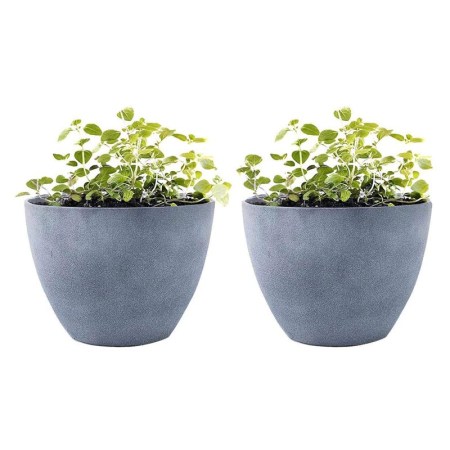We may earn revenue from the products available on this page and participate in affiliate programs. Learn More ›
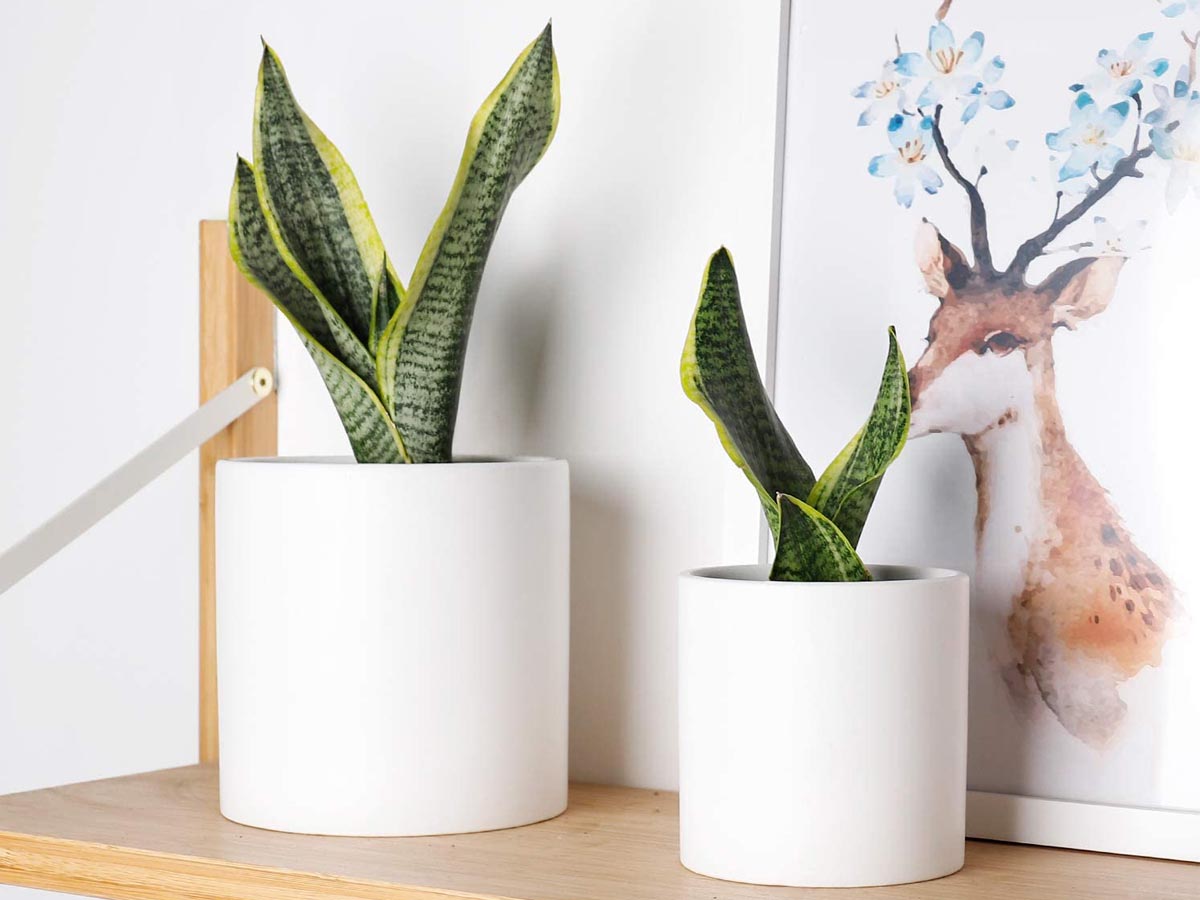
Decorating a space with greenery adds color and life to the room it inhabits. Plants improve indoor air quality, have the ability to elevate one’s mood, and are delightfully affordable when compared to other home decor, as are most planters.
From hanging pots for succulents and aloe plants, to containers for housing tropical florals, some planters are better suited to certain environments than others. Self-watering planters offer a convenient, low-maintenance option for indoor gardens—something to keep in mind if you’ve got a busy schedule or worry about overwatering.
Keep reading for more tips on how to choose the best planters for your home, and explore some of these top picks in a variety of sizes and styles.
- BEST OVERALL: Greenaholics White Ceramic Plant Pots
- BEST BUDGET: Bloem Saturn Planter with Saucer
- BEST SELF-WATERING: HBServices 6″ Self Watering + Self Aerating Pot
- BEST HANGING: Umbra Triflora Hanging Planter for Window
- BEST TERRARIUM: NCYP Gold Glass Geometric Terrarium
- BEST FOR SUCCULENTS: ZOUTOG Succulent Planter, White Mini 3.15-inch
- BEST FOR OUTDOOR SPACES: LA JOLIE MUSE Flower Pot Garden Planters
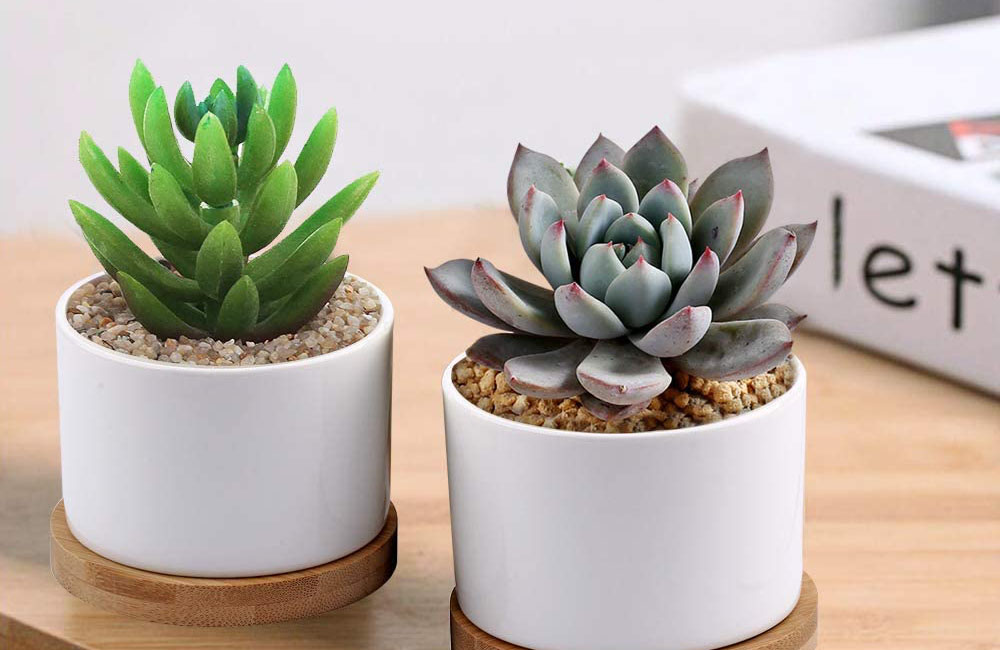
What to Consider When Choosing the Best Planters
Planters come in a wide variety of designs, materials, finishes, and sizes. While aesthetics might be top of mind when shopping for a planter, there are some other important features to consider as well, such as the planter type, size, material, style, and drainage system. Below are some characteristics to keep in mind to help you choose the perfect plant pots for your needs.
Planter/Pot Type
Beyond their look, different planter types are suitable for different settings or plant types. Common planter types include standard planters, nursery planters, self-watering pots, hanging planters, and terrariums.
- Standard: Standard planters encapsulate a whole range of planters made to display plants both indoors and outdoors. Standard planters come in a range of sizes and are usually bowl or U-shaped. Rectangular and square options are also available.
- Nursery: Nursery planters refer to the pots that plants arrive in. These small plastic pots are usually intended for holding and transporting the plant. Although some plants can be left in their nursery planter and placed in a decorative pot, others should be moved into a more suitable planter after purchase.
- Self-watering: Self-watering plant pots are designed to keep plants sufficiently watered using a reservoir and drainage system. They provide a consistent amount of moisture to the root of the plant and can prevent over- or under-watering.
- Hanging: Hanging planters hang from the ceiling or wall. Hanging planters or baskets are suitable for a variety of plants, but trailing plants like spider plants and string of pearls can add a pretty flair with their draping leaves.
- Terrarium: Terrariums are like small cages for plants; they’re a popular way to display succulents. They often feature clear glass or plastic panes inside a wood, plastic, or metal frame.
Size
Various plant species require more or less room for root development, so it’s important to select a planter that’s large enough to accommodate the desired plant. For example, small succulents and air plants can grow in pots as small as a few inches across without becoming root-bound.
Almost all plants have to be repotted at some point in their life cycle, so they should be given some room to grow. However, plant pots that are too large may lead to excess water in the soil, which can cause mold growth and diseases like root rot.
Most plants grow well in containers that are at least 2 inches larger in diameter than the plant itself. Plant varieties with an extensive root system, like banana plants, require deeper pots. On the other hand, cacti, snake plants, bonsai trees, and other shallow-rooted plants are better suited to planters with little depth.
Material
Planters are commonly made of ceramic, plastic, metal, concrete, and terra cotta. Each material offers its own advantages when it comes to design and function. Style plays a big part in choosing a planter, and materials play a big role in aesthetics. Consider the material’s suitability for your intended use, keeping in mind factors like water resistance and durability.
- Ceramic: Ceramic planters come in a range of colors, patterns, and textures, and they can be made to suit almost any home style. Their glazed finish protects them from the elements, making them a good choice for both indoor and outdoor plants. However, they can crack in very cold weather. Keep in mind that ceramic planters aren’t indestructible, and large planters can be costly and heavy
- Plastic: Plastic plant pots tend to be plainer, but they’re inexpensive, lightweight, and utilitarian. They’re also waterproof, which makes them suitable for damp outdoor conditions. Plastic can be made to look like other materials, but for a fraction of the cost.
- Metal: Metal planters are durable and can offer a sleek look. A range of metal types are available, including aluminum, stainless steel, copper, and zinc. Take note of the type of metal and the manufacturer’s recommendations; some metal planters can be used outdoors without rusting.
- Concrete: Concrete planters look modern and understated—an ideal choice for contemporary homes and gardens. They’re suitable for indoor and outdoor use. Concrete is also very heavy, making these planters tough to move but excellent for keeping top-heavy plants in place.
- Terra cotta: Terra cotta is a classic planter material that comes in a variety of shapes and sizes. Terra cotta has a naturally warm and earthy coloring. While a terra cotta clay pot is suitable for outdoor use, it can crack in very cold weather conditions.
Style
A pot or planter will create the optimal visual effect if it complements the surrounding decor. Consider the most common interior (or exterior) design types:
- Modern: Planters with a modern style contain clean lines, typically with polished or metallic finishes. Geometric designs are also popular. Consider choosing a planter in a color that contrasts with the furniture or the draperies.
- Traditional: Planters with a traditional design pair well with historical homes, craftsman architecture, and spaces with a vintage feel. Opt for a vessel with an aged aesthetic that’s shaped like an urn or resembles a statue. Avoid bright colors in favor of black, gray, or brown.
- Farmhouse: The inherent charm of farmhouse design combines primary colors and a hint of rustic appeal to create a comfortable, lived-in feeling. Select a planter with simple lines in white, brown, or muted earth tones to complement the room.
- Industrial: This trending style often incorporates iron elements that create a look reminiscent of yesteryear factories and loading docks. To achieve this result, select a black metal planter or one in copper or brass.
- Bohemian: This free-spirit style features bold colors and lively patterns to create a relaxed or shabby-chic aesthetic. Think planters with jute or wicker covers, geometrics, and multitone exteriors.
Drainage and Aeration
Drainage is an important factor to look for in a new planter—plants need air as much as they need water. Overwatering can contribute to a houseplant’s demise just as easily as neglect. To prevent sad and soggy plants, look for planters with drainage holes. Drainage holes are located at the bottom of the planter to allow excess water to flow through and prevent waterlogged roots.
Drainage holes can also contribute to aeration. Waterlogged soil won’t let air pass through, but properly drained soil will. This means that adequate drainage also gives the plant roots much-needed access to oxygen, a key element for thriving and healthy houseplants.
If there’s a planter that’s too pretty to pass up but lacks a drainage hole, consider planting the plant in a smaller pot with a drainage hole. Then place the smaller pot inside of the larger, decorative planter.
Our Top Picks
Ready to give your plants a pretty new home? Read on for a list of recommendations of the best planters to add to your windowsill, countertop, patio, or backyard.
Best Overall
Greenaholics White Ceramic Plant Pots
See ItThese Greenaholics pots come in a pack of two, with one 6-inch by 6-inch pot and another pot measuring 4.7 inches round by 5.1 inches high, making them ideal for small- to medium-size plants. The pots have a minimalistic look with a smooth yet scratch-resistant surface, so they work well for indoor and outdoor plantings where greater durability is required.
These versatile pots should add a modern touch to most indoor or outdoor gardens. The ceramic containers feature drainage holes with rubber plugs that can be left in to retain moisture or removed for indoor plants that require well-drained soil. Add a decorative tray to catch any draining water, or move the pots to the sink when watering.
Product Specs
- Product Dimensions: 6 by 6 inches, 4.7 by 5.1 inches
- Materials: Ceramic
- Drainage holes: Yes
Pros
- Includes two matching pots
- Scratch-resistant matte finish
- Contains drainage holes with rubber stoppers
- Easy to clean
Cons
- Drip trays not included
Best Budget
Bloem Saturn Planter with Saucer
See ItAn affordable pot for flowers, houseplants, or greenery, the Bloem planter offers a simple solution in a wide variety of vibrant colors, ranging from earthy yellow to calypso blue to tequila sunrise orange. The pots come with matching saucers. The Saturn Planter also has predrilled drain holes, so you won’t need to worry about drilling your own.
The plastic is made to resist color fading and damage from scratches, so these pots can easily be used indoors or outdoors for flowers or greenery. These affordable pots are 5 by 5 by 4.5 inches, so they’re best for small- to medium-size plants. These planters are also available in larger sizes, all the way up to a generous 14 inches.
Product Specs
- Product Dimensions: 5 by 4.5 inches
- Materials: Plastic
- Drainage holes: Yes
Pros
- Wide variety of sizes and colors available
- Matte finish resists scratches, dirt, and fingerprints
- Matching drip tray included
Cons
- Tight-fitting drip tray may overflow
Best Self-Watering
HBServices 6u0022 Self Watering + Self Aerating Pot
See ItThe HBServices self-watering planter is a suitable size for a variety of flowers and has drainage slats on the bottom that also help aerate the soil around the roots. The planter comes with a removable water reservoir to bypass the soil, and it takes up water through four hollow legs to prevent overwatering or accidentally flushing out necessary soil nutrients.
Since it self-waters, this planter works well for African violets, geraniums, lilies, poinsettias, impatiens, hydrangeas, and other flowering plants. This 6-inch planter holds 1.6 quarts, but for larger plants, small decorative trees, and mixed container gardens, there is an ample 12-inch version, which holds 3.6 gallons and features wheels for easy movement from location to location.
Depending on the humidity (and other conditions), these planters should be able to go 2 weeks without being watered—a convenience for busy people or for those who travel and want greenery in their home or office.
Product Specs
- Product Dimensions: 6 by 5.9 inches
- Materials: Plastic
- Drainage holes: Yes
Pros
- Deep reservoir holds 8 ounces of water
- Extra drainage slats allow for better aeration
- UV-stabilized plastic build won’t fade or become brittle
Cons
- Glossy, plain plastic may look cheap to some users
Best Hanging
Umbra Triflora Hanging Planter for Window
See ItThis tri-pot planter from Umbra offers a neat industrial aesthetic when placed in front of a window or wall. These hanging pots offer gardening flexibility and sleek style when you’re short on flat surfaces or windowsills.
Each decorative pot is designed to hold a 3-inch plastic pot, eliminating the need for repotting and making these indoor planters well suited for smaller plants, herbs, or succulents. The hanging bar measures 24.75 inches long, and you can mount this planter on a ceiling or wall with the included mounting hardware.
These pots don’t have holes in the bottom for drainage—a consideration to think about if planting directly into the pots, especially for plants that need good drainage. Adding gravel at the bottom of the pots can help improve drainage.
Product Specs
- Product Dimensions: 24.75 inches by 42 inches
- Materials: Steel and melamine
- Drainage holes: No
Pros
- Fit standard 3-inch pots
- Adjustable planter spacing and hanging length
- Can be wall or ceiling mounted
Cons
- Requires tools for installation
Best Terrarium
NCYP Gold Glass Geometric Terrarium
See ItMeasuring 6.89 by 5.91 by 6.89 inches, this pentagon-shaped terrarium is ideal for small plants, such as air plants and succulents. This geometric glass terrarium has gold metal accents but is also available in black or silver metal trim. Its open face can be turned to point either up or to one side, so you can play around with the look.
Note that NCYP’s geometric terrarium is not watertight, so plan to incorporate some type of absorbent material, such as moss, into the soil to prevent leaks.
Product Specs
- Product Dimensions: 6.89 by 5.91 inches
- Materials: Glass and copper alloy
- Drainage holes: No
Pros
- Ideal for tabletop displays
- Attractive dodecahedron shape
- Two color/finish options
Cons
- Lacks drainage system
Best for Succulents
ZOUTOG Succulent Planter, White Mini 3.15-Inch
See ItIf you have an indoor succulent garden or are considering starting one, the ZOUTOG set of four succulent pots comes with bamboo trays, allowing for an easy and eye-catching display. These mini pots measure 3.15 by 3.15 by 2.17 inches, making them the perfect modern planter for smaller plants such as succulents.
The ceramic pots are available in white and have a smooth finish for a clean, modern look. They also have a built-in drainage hole ready to help dry out the soil, which is especially important as succulents prefer a drier, well-drained environment. The small, smart-looking planters work great individually or as a neat plant grouping on a windowsill or shelf.
Product Specs
- Product Dimensions: 3.15 by 2.17 inches
- Materials: Ceramic and bamboo
- Drainage holes: Yes
Pros
- Includes four matching mini planters
- Modern and simple design
- Stylish bamboo drip trays
Cons
- Bamboo trays may warp
Best for Outdoor Spaces
LA JOLIE MUSE Flower Pot Garden Planters
See ItThese outdoor planters from La Jolíe Muse offer the look of stone without the heaviness or expense. Made with recyclable plastic, these planters measure 11.3 by 11.3 by 8.7 inches, making them appropriate for decorative trees, tropical plants, or housing a combination of plants in one pot.
The two pots are made to withstand damage from the elements and resist cracks, color fading, and peeling for year-round outdoor use. They’re much lighter than ceramic or concrete planters and can be easily moved outdoors or inside for winter. Each comes with four holes predrilled in the bottom (a saucer is not included).
Product Specs
- Product Dimensions: 11.3 by 8.7 inches
- Materials: Plastic
- Drainage holes: Yes
Pros
- Realistic stone-like finish
- Weather-resistant for outdoor use
- Lightweight and easy to move
Cons
- Drip trays not included
Our Verdict
The right planters can elevate your space and keep plants thriving. Made from ceramic and with a matte white finish, Greenaholics ceramic planters are perfect for those who are looking for a sleek and modern option. For those looking to save, the Bloem planter comes in a range of fun colors, includes drainage holes, and comes with a matching drip tray.
How We Chose the Best Planters
Planters come in a large selection of styles, shapes, colors, materials, and sizes. Shoppers are spoiled for choice when it comes to planters, so choosing the right one can feel overwhelming.
For most shoppers, aesthetics is a top priority when choosing a planter. A planter should double as a decor piece while also keeping your plant healthy. Style is very individual, but we made sure to choose attractive and versatile pieces that will suit various decor types.
Through product research, we also examined the planter materials, construction, and functionality. We chose planters with sturdy and thick materials (flimsy planters look cheap and won’t last). When needed, most of the products on this list included any necessary parts and hardware, like mounting hardware or drip trays.
FAQs
The best planters for your home are pretty and practical to elevate your decor and keep plants thriving. Beyond a stylish look, they should also be suitable for the plant and your intended use. If you’re still searching for the perfect planter to house your greenery, explore the frequently asked questions below.
Q. What plants grow in small pots?
Plenty of plants can grow in small pots, including ferns, succulents, aloe vera, air plants, and many herbs.
Q. What large plants do well in pots?
Fiddle leaf figs, bamboo, monsteras, rubber plants, and money trees can thrive in large indoor planters and make a statement in your home.
Q. What plants are good for hanging planters?
Spider plants, English ivy, string of pearls, and pothos plants have a pretty draping effect that looks lovely in hanging planters.
Q. What plants work best in a terrarium?
Slow-growing, low-maintenance succulents, ferns, air plants, and some carnivorous plants do well in terrariums.
Q. Are self-watering pots good for all plants?
No, self-watering pots are not suitable for plants that require dry soil between waterings.
Q. Which pots are best for outdoor plants?
For outdoor plants, choose a pot that is durable and heavy enough to withstand windy, rainy, and cold weather.
